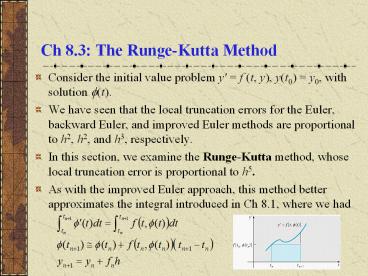Ch%208.3:%20The%20Runge-Kutta%20Method PowerPoint PPT Presentation
Title: Ch%208.3:%20The%20Runge-Kutta%20Method
1
Ch 8.3 The Runge-Kutta Method
- Consider the initial value problem y' f (t, y),
y(t0) y0, with solution ?(t). - We have seen that the local truncation errors for
the Euler, backward Euler, and improved Euler
methods are proportional to h2, h2, and h3,
respectively. - In this section, we examine the Runge-Kutta
method, whose local truncation error is
proportional to h5. - As with the improved Euler approach, this method
better approximates the integral introduced in Ch
8.1, where we had
2
Runge-Kutta Method
- The Runge-Kutta formula approximates the
integrand - f (tn, ?(tn)) with a weighted average of its
values at the two endpoints and at the midpoint.
It is given by - where
- Global truncation error is bounded by a constant
times h4 for a finite interval, with local
truncation error proportional to h5.
3
Simpsons Rule
- The Runge-Kutta formula is
- where
- If f (t, y) depends only on t and not on y, then
we have - which is Simpsons rule for numerical
integration.
4
Programming Outline Runge-Kutta Method
- Step 1. Define f (t,y)
- Step 2. Input initial values t0 and y0
- Step 3. Input step size h and number of steps n
- Step 4. Output t0 and y0
- Step 5. For j from 1 to n do
- Step 6. k1 f (t, y)
- k2 f (t 0.5h, y 0.5hk1)
- k3 f (t 0.5h, y 0.5hk2)
- k4 f (t h, y hk3)
- y y (h/6)(k1 2k2 2k3 k4)
- t t h
- Step 7. Output t and y
- Step 8. End
5
Example 1 Runge-Kutta Method (1 of 2)
- Recall our initial value problem
- To calculate y1 in the first step of the
Runge-Kutta method for h 0.2, we start with - Thus
6
Example 1 Numerical Results (2 of 2)
- The Runge-Kutta method (h .05) and the improved
Euler method (h .025) both require a total of
160 evaluations of f. However, we see that the
Runge-Kutta is far more accurate. - The Runge-Kutta method (h .2) requires 40
evaluations of f and the improved Euler method
requires 160 evaluations of f, and yet the
accuracy at t 2 is similar.
7
Adaptive Runge-Kutta Methods
- The Runge-Kutta method with a fixed step size can
suffer from widely varying local truncation
errors. - That is, a step size small enough to achieve
satisfactory accuracy in some parts of the
interval of interest may be smaller than
necessary in other parts of the interval. - Adaptive Runge-Kutta methods have been developed,
resulting in a substantial gain in efficiency. - Adaptive Runge-Kutta methods are a very powerful
and efficient means of approximating numerically
the solutions of a large class of initial value
problems, and are widely available in commercial
software packages.

